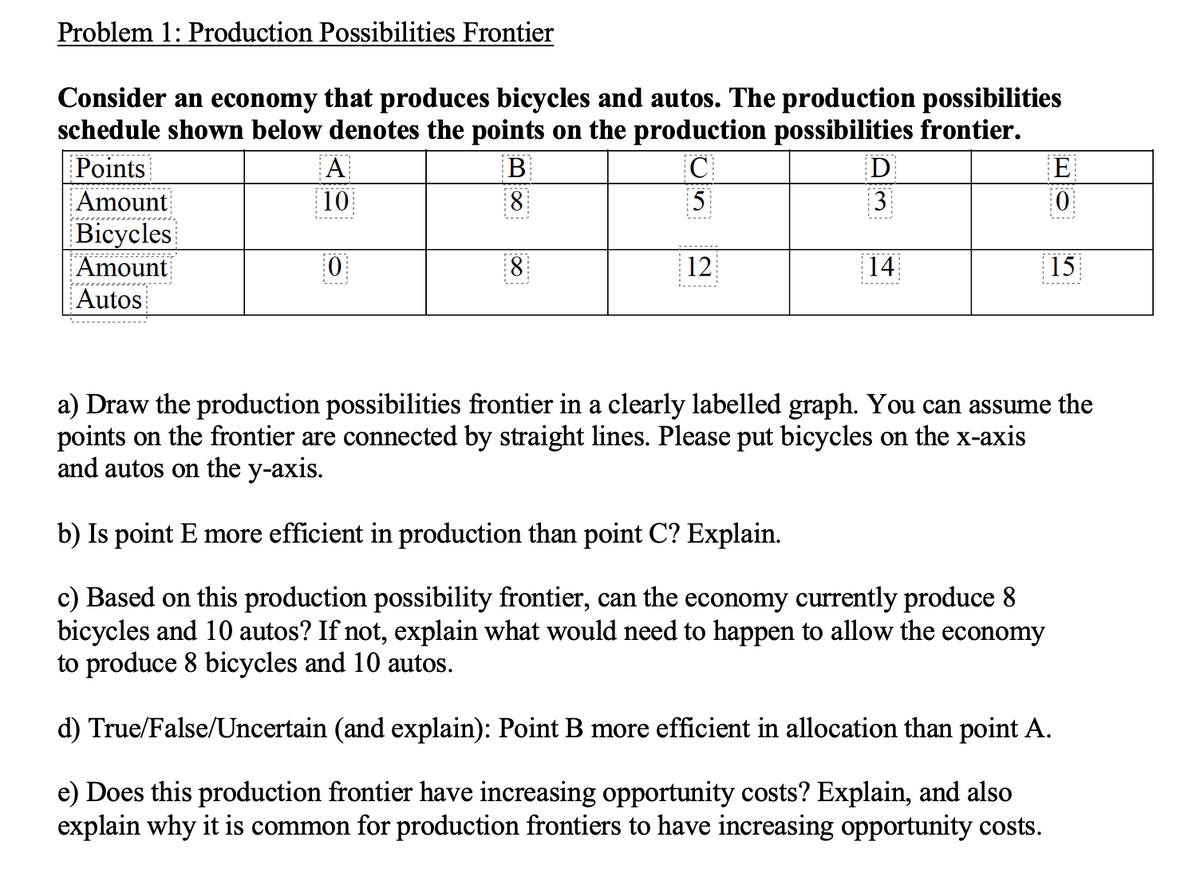Consider an economy that produces bicycles and autos. The production possibilities schedule shown below denotes the points on the production possibilities frontier. A C 5 Points B D E Amount 10 8. 3 i....... ..... .... .... Bicycles Amount Autos 8: 12 14 15 .... ...... i...... ....... .............. a) Draw the production possibilities frontier in a clearly labelled graph. You can assume the points on the frontier are connected by straight lines. Please put bicycles on the x-axis and autos on the y-axis. b) Is point E more efficient in production than point C? Explain. c) Based on this production possibility frontier, can the economy currently produce 8 bicycles and 10 autos? If not, explain what would need to happen to allow the economy to produce 8 bicycles and 10 autos.
Consider an economy that produces bicycles and autos. The production possibilities schedule shown below denotes the points on the production possibilities frontier. A C 5 Points B D E Amount 10 8. 3 i....... ..... .... .... Bicycles Amount Autos 8: 12 14 15 .... ...... i...... ....... .............. a) Draw the production possibilities frontier in a clearly labelled graph. You can assume the points on the frontier are connected by straight lines. Please put bicycles on the x-axis and autos on the y-axis. b) Is point E more efficient in production than point C? Explain. c) Based on this production possibility frontier, can the economy currently produce 8 bicycles and 10 autos? If not, explain what would need to happen to allow the economy to produce 8 bicycles and 10 autos.
Chapter2: Productions Possibilities, Opportunity Costs, And Economic Growth
Section: Chapter Questions
Problem 6SQP
Related questions
Question

Transcribed Image Text:Problem 1: Production Possibilities Frontier
Consider an economy that produces bicycles and autos. The production possibilities
schedule shown below denotes the points on the production possibilities frontier.
Points
Amount
Bicycles
Amount
Autos
A
10
B
8
D
E
5
8
12
14
15
a) Draw the production possibilities frontier in a clearly labelled graph. You can assume the
points on the frontier are connected by straight lines. Please put bicycles on the x-axis
and autos on the y-axis.
b) Is point E more efficient in production than point C? Explain.
c) Based on this production possibility frontier, can the economy currently produce 8
bicycles and 10 autos? If not, explain what would need to happen to allow the economy
to produce 8 bicycles and 10 autos.
d) True/False/Uncertain (and explain): Point B more efficient in allocation than point A.
e) Does this production frontier have increasing opportunity costs? Explain, and also
explain why it is common for production frontiers to have increasing opportunity costs.
Expert Solution
This question has been solved!
Explore an expertly crafted, step-by-step solution for a thorough understanding of key concepts.
This is a popular solution!
Trending now
This is a popular solution!
Step by step
Solved in 3 steps with 3 images

Knowledge Booster
Learn more about
Need a deep-dive on the concept behind this application? Look no further. Learn more about this topic, economics and related others by exploring similar questions and additional content below.Recommended textbooks for you








